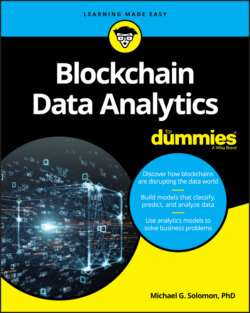Читать книгу Blockchain Data Analytics For Dummies - Michael G. Solomon - Страница 21
Classifying entities
ОглавлениеAn entity is any object that your data describes, such as a customer, a vendor, a product, an order, or anything else that has characteristics data items can describe. In traditional database terms, an entity would correspond to a record or a row. The concept of a row maps to a spreadsheet concept as well. Think of a spreadsheet of customers. Each row would contain all the data that describes a single customer. Figure 1-1 shows a collection of customers in a table format.
These customers are stored in a comma-separated value (CSV) text file named customer.csv, and displayed in Visual Studio Code using the Edit as CSV extension. To learn more about Visual Studio Code and its extensions, see Chapter 4.
Note that each customer has a set of characteristics, such as name, address, and contact, stored in separate columns. Data analytics models use these different characteristics, also called features, to examine how different entities are related.
FIGURE 1-1: Customer entities presented as a table.
One type of analysis is to examine the features of different entities to see if some features can help group entities or imply some relationship. For example, suppose you asked a group of people to name their favorite baseball team. You would expect that most people who answered “the Colorado Rockies” most likely live near Colorado. However, you can’t always make such simple associations. If you asked the same question in the 1990s, not everyone who answered “the Atlanta Braves” lived in Georgia. During the 1990s, cable TV was becoming popular and Turner Broadcasting System, whose owner also owned the Braves, broadcast all Braves games nationally. Many people who didn’t live in Georgia became Braves fans.
The Braves example shows that analytics models cannot be trusted unconditionally. Data analytics can provide tremendous value but also requires care and diligence to build models that return results that hold true over time.
Assuming that you invest sufficiently to build good models, classification models can help to identify entities that are similar. Similarity information helps organizations develop targeted marketing campaigns and services to give customers and partners the sense of being treated individually. You learn about several classification models in Chapter 7 and build a few in Chapter 10.
